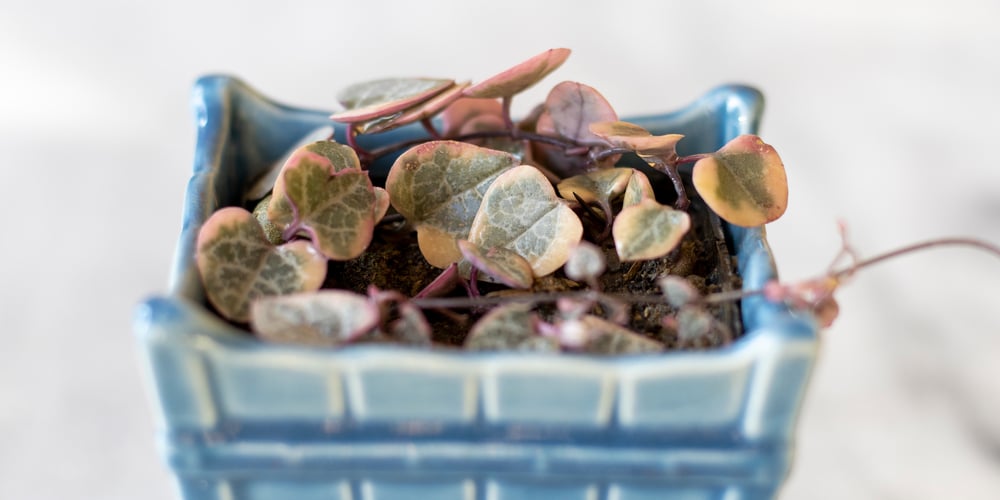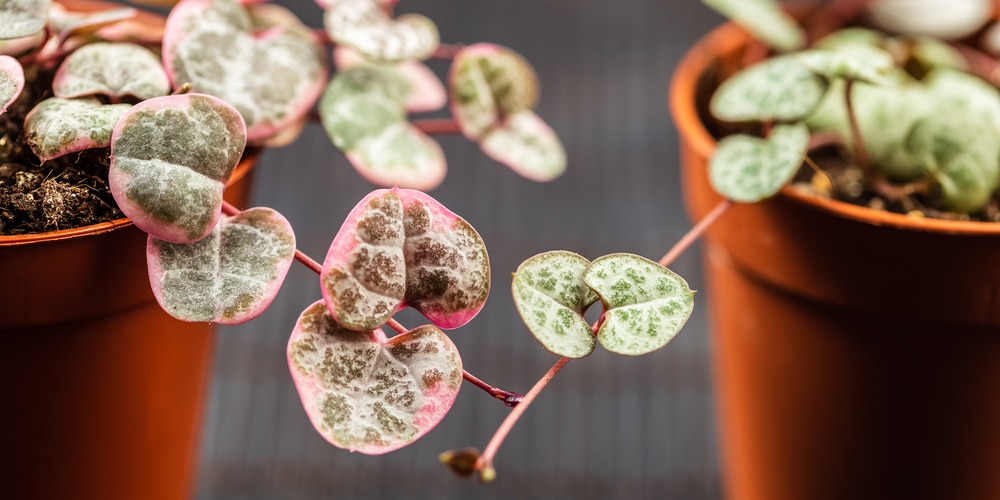The String of Hearts is a dainty and beautiful trailing succulent, with heart-shaped foliage that’s colored cream and green with pink streaks here and there.
It’s easy to make a mistake and give it too much water- an overwatered string of hearts will exhibit edema, mushy, yellow and droopy leaves and root rot.
Signs of an Overwatered String of Hearts
Succulents such as string of hearts demand infrequent watering and low humidity, and if you don’t follow this then these overwatered signs might occur:
- Edema
- Yellowed and droopy leaves
- Root rot
- Wilt and dropping foliage
Edema
Edema is characterized by small spots of black or red spots in the leaves of the string of hearts. The cause of edema is overwatering due to the plant absorbing too much water and not having the means to dispose of it.
The bursts of black or red blisters is a sure sign of overwatering. This means you should take immediate action so it won’t happen to the other leaves.
Droopy and Yellowed Leaves
Yellowing leaves is one of the most common signs of overwatering not just for the string of hearts but for nearly every plant.
Your succulent experiences nutrient deficiency as trace minerals are washed out in the soil. It’s usually accompanied by the stems going soft and limp.
Root Rot
Root rot is a sure sign that you’re overwatering your string of hearts. The roots turn from healthy to rotten and will take on a black or dark brown appearance.
Furthermore, you might smell a rank odor coming from the soil which confirms the condition.
Dropping and Wilting Leaves
Root rot usually leads to a plant shedding its leaves to try and conserve energy. As it goes on survival mode, the leaves slowly wilt and drop off.
It’s not unusual for leaf yellowing to accompany wilting and dropping. This may not be noticeable at first, especially if the plant is lush and thriving but then you’ll be quickly left with a straggly string of hearts with bare and limp stems.
How to Fix an Overwatered String of Hearts
Suspect Overwatering? Stop and Observe
If any of the signs above can be seen in your string of hearts plant, the first thing to do is stop watering. Remember that it’s a succulent and can survive for days without a drink. They naturally dislike having to sit on wet soil for prolonged periods.
A good rule of thumb in watering a string of hearts is to feel the top soil of the plant and see if it’s moist or dry. To this end you can use a moisture meter or your finger to poke through the soil.
Lower Humidity Levels
String of hearts prefer low humidity environments so the leaves won’t hold too much water. Ideally, you should keep it down to around 40% to reduce the risk of edema.
You can get a dehumidifier to control room humidity and allow your string of hearts to transpire water more efficiently.
Severe Overwatered String of Hearts? Repot
Your best bet to fix an overwatered string of hearts is to remove it from its current condition and do a reset. This might entail more time and effort from you, but it’s usually enough to save your dying succulent.
Uproot the plant gently and shake it so excess soil gets dislodged from the roots. Take a closer look at the roots and remove the blackened or brown ones using sterilized pruning shears or scissors. You can also take this time to remove dead, yellowed or brown foliage along the stems.
Set the string of hearts aside and let air flow through the wet roots. After a few hours, you can prepare a new soil mix and container for the succulent to live in. Make sure that it has adequate holes and that the soil drains well so water won’t stay inside for too long.
Moisten the soil and do not water again until the top inch is dry to the touch. Generally, string of hearts only needs a once-a-week watering during spring and summer, and once a month or so during the winter season. Also, do not let it sit on a saucer or tray of water for too long.
Related Article: String of Needles Plant: Growth and Care

